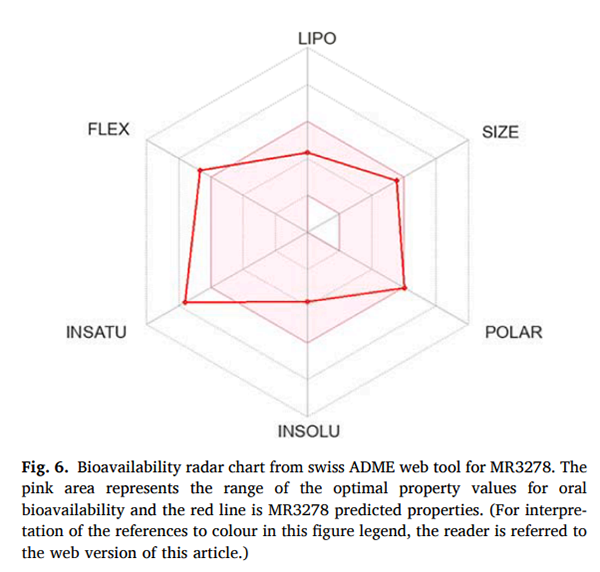The main reasons for the failure of new drugs in clinical trials are related to unsatisfactory pharmacokinetic characteristics and toxicity issues. Therefore, this article explores the drug like properties of MR3278 through computer ADMET analysis.
As shown in the bioavailability radar chart, the high bioavailability of MR3278 can be attributed to its optimal physicochemical properties. The radar chart contains six key parameters of oral bioavailability: LIPO (lipophilicity), SIZE (molecular size), POLAR (polarity), INSOLU (solubility), INSATU (saturation), and FLEX (flexibility).

Next, use SwissADME, PreADMET, and pkCSM databases to predict the different ADMET parameters of MR3278.

In terms of absorption parameters, MR3278 would be a good candidate for oral medication due to its excellent human intestinal absorption (HIA, 92.73%). However, its CaCo-2 model value is 3.14. In terms of distribution parameters, MR3278 exhibits low permeability in the blood-brain barrier, with a value of 0.053 (less than 0.1), indicating its advantage in reducing adverse reactions in the central nervous system. Cytochrome P450 (CYP450) is a family of enzymes primarily present in the liver, responsible for detoxifying exogenous substances such as toxins or drugs and clearing them from the body. According to PreADMET data, MR3278 is a potential inhibitor and substrate for different CYP450 enzymes. In addition, MR3278 excretion was evaluated based on the predicted total clearance rate (Log CLtot, ml/min/kg), and it was inferred whether it was a substrate of renal uptake transporter protein (OCT2). The results of pkCSM indicate that the expected Log CLtot value is 0.17, and MR3278 is not a renal OCT2 substrate, which means that the drug is cleared and excreted by the kidneys in a steady state in vivo.
Evaluate the toxicity prediction of MR3278 using PreADMET. As shown in the table above, MR3278 has no carcinogenic activity in rats, and its acute toxicity prediction to algae, fish, and water fleas shows low toxicity levels. The Ames test is a simple method for determining the mutagenicity of compounds on Salmonella typhimurium strains. The Ames toxicity test of MR3278 was negative, indicating that the toxicity level of the formulation is low and there is no mutagenic effect. In addition, MR3278 did not violate any drug similarity rules (Lipinski, Ghose, Veber, Egan, and Muegge). According to computer predictions, MR3278 is believed to have ideal drug like properties.
This article develops a novel PI3K δ inhibitor based on a 2-aminopyridine skeleton using a bioelectronic isodisplacement strategy. MR3278 exhibits high activity against PI3K δ (IC50=30nM) and shows better anti proliferative activity against most AML cells compared to Idelalisib. In addition, MR3278, as a potential PI3K δ inhibitor, significantly inhibits the PI3K/AKT pathway and exhibits dose-dependent induction of apoptosis and G2/M cycle arrest in Mv-4-11 cells.
In summary, these results suggest that MR3278 may be a new lead compound for PI3K δ inhibitors, and similar structural compounds are currently being further refined and evaluated for in vivo anti-tumor efficacy.
References
1. Daina A, Michielin O, Zoete V. SwissADME: a free web tool to evaluate
pharmacokinetics, drug-likeness and medicinal chemistry friendliness of small molecules. Sci Rep-UK.
2017;7:42717.
2. Pires DEV, Blundell TL, Ascher DB. pkCSM: predicting small-molecule
pharmacokinetic and toxicity properties using graph-based signatures. J Med Chem.
2015;58:4066–4072.
3. Lipinski CA, Lombardo F, Dominy BW, Feeney PJ. Experimental and computational approaches to estimate solubility and permeability in drug discovery and development settings (Reprinted from Advanced Drug Delivery Reviews, vol 23, pg 3–25, 1997). Adv Drug Deliver Rev.
2001;46:3–26.
4. Ghose AK, Viswanadhan VN, Wendoloski JJ. A knowledge-based approach in designing combinatorial or medicinal chemistry libraries for drug discovery. 1. A qualitative and quantitative characterization of known drug databases. J Comb Chem. 1999;1:55–68.
5. Veber DF, Johnson SR, Cheng HY, Smith BR, Ward KW, Kopple KD. Molecular
properties that inffuence the oral bioavailability of drug candidates. J Med Chem.
2002;45:2615–2623.
6. Egan WJ, Merz KM, Baldwin JJ. Prediction of drug absorption using multivariate statistics. J Med Chem. 2000;43:3867–3877.
7.Muegge I, Heald SL, Brittelli D. Simple selection criteria for drug-like chemical matter. J Med Chem.
2001;44:1841–1846.